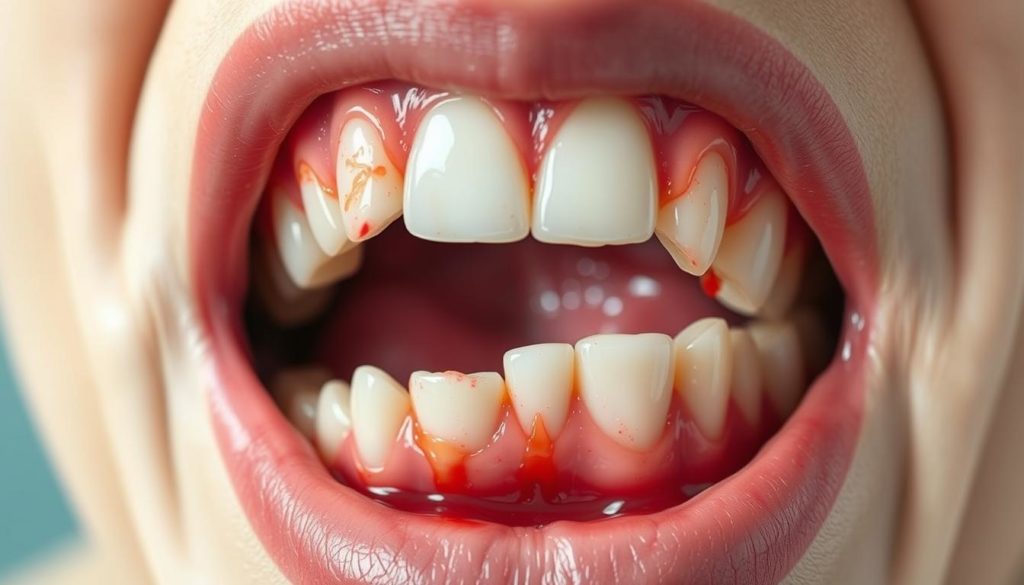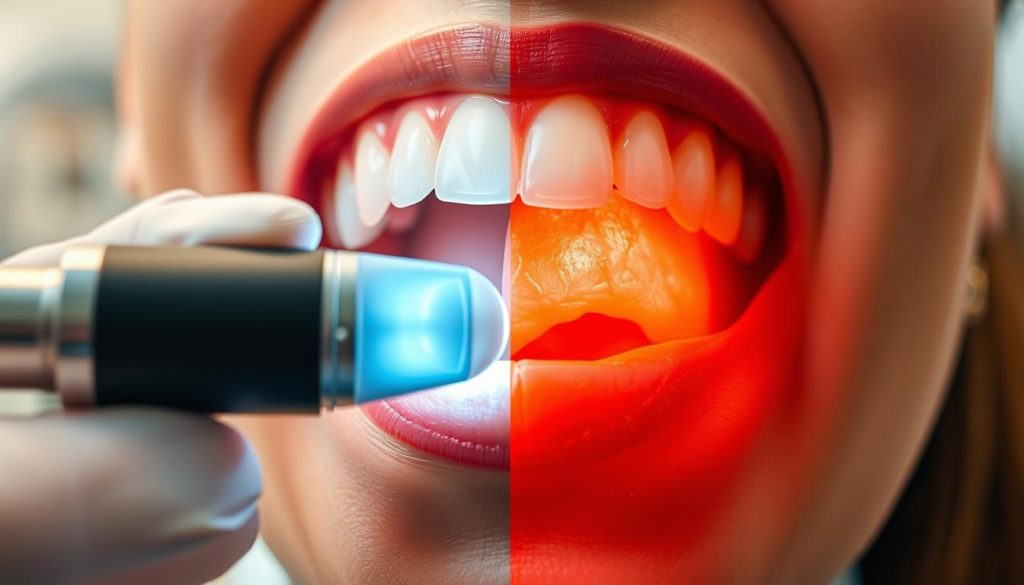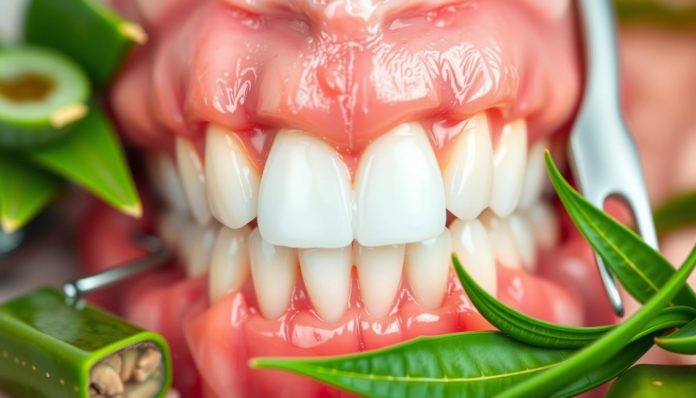Did you know that nearly half of American adults aged 30 and over have some form of gum disease? This shows how crucial it is to deal with periodontal disease treatment early and efficiently.
Gum disease can be quiet at first but might impact not just your mouth, but your whole health. This guide will cover different ways to keep your gums healthy and avoid more issues.
Understanding Gum Disease: Causes and Symptoms
Gum disease affects a lot of people’s mouths. It starts mild but can get worse quickly if ignored. We’ll look at what causes it, the symptoms, and how it changes over time.

Causes of Gum Disease
Gum disease has a few causes. The main one is bacterial plaque, a sticky layer on your teeth. If not cleaned off, plaque becomes tartar and leads to infection. Smoking, diabetes, genes, and less saliva from some meds also play a role. It’s very important to keep your mouth clean to avoid these problems.
Common Symptoms of Gum Disease
Catching gum disease early can stop worse issues. Look out for these signs:
- Swollen or puffy gums
- Bleeding gums during brushing or flossing
- Persistent bad breath
- Receding gums
- Tenderness or discomfort in the gums
Breath that stays bad and gums that bleed are big early warning signs. They mean you should see a dentist quick.
Stages of Periodontal Disease
Periodontal disease goes through stages, from gingivitis to periodontitis. Let’s check each one:
| Stage | Description |
|---|---|
| Gingivitis | This first stage causes gum inflammation and bleeding. But it can be fixed with good mouth care and dentist visits. |
| Early Periodontitis | Now, the infection reaches the bone. Symptoms like more bleeding and a bit of bone loss show up. |
| Moderate Periodontitis | If still ignored, you get moderate bone loss and gums pull back. This might lead to loose teeth and needing fake ones. |
| Advanced Periodontitis | In the worst stage, there’s a lot of bone loss, deep gum gaps, and maybe loss of teeth and bone, needing surgery. |
Knowing how periodontitis changes makes it easier to get help early. This can stop the disease when it’s not too late.
The Importance of Early Detection
Finding gum disease early is key to beating it. By going for regular oral health examinations, you can catch signs early. This helps stop problems before they get worse. A good routine makes this possible.

Early diagnosis of gum disease means you can choose simpler treatments. Seeing your dentist often helps find issues early. Acting fast can stop the disease from getting worse.
Spotting problems early means your mouth stays healthier. It can also mean spending less money on treatment. Early action helps your overall health and lowers the risk of bad gum disease.
- Improved chances of gum disease prevention
- Less invasive treatment options
- Enhanced oral and systemic health
Keeping up with oral health exams and catching symptoms early is crucial. It helps make treatments more effective. Catching a problem early means a better chance for a healthy smile.
Non-Surgical Gum Disease Treatments
Non-invasive methods like dental scaling and root planing, along with antibiotic therapy, are great for treating gum disease. They not only manage symptoms but also tackle the root causes of the infection. This helps keep your gums healthy without surgery.
Scaling and Root Planing
Dental scaling and root planing combine for a deep clean that tackles tartar and plaque under and above the gum. This procedure is key in stopping harmful bacteria from causing gum disease. By removing hard deposits and smoothing root surfaces, it prevents new plaque and tartar from forming.
| Treatment | Description |
|---|---|
| Dental Scaling | Removes tartar and plaque from above and below the gum line. |
| Root Planing | Smooths the root surfaces to prevent new bacteria buildup and promote healing. |
Antibiotic Therapy
Antibiotics play a big role in fighting stubborn infections in gum disease treatment. They can come as topical gels for the gums or oral medications for the whole body. These treatments lower bacteria levels, helping make the gums healthier without surgery. This is a key part of stopping gum disease in a gentle way.
Surgical Treatments for Advanced Gum Disease
Patients facing severe gum disease can find relief through surgery. The main treatments include periodontal surgery, flap surgery, bone grafting, and tissue regeneration. Each method targets different aspects of the disease.
Flap surgery involves cutting into the gums to clean the roots and bone. This process removes tartar and bacteria. It helps lower inflammation and gets rid of harmful pockets.
Bone grafting helps those who have lost bone to infection. It uses natural or man-made bone to encourage new growth. This strengthens the foundation for teeth and improves stability.
With tissue regeneration, a barrier helps new bone and gum tissue grow. This is often used with bone grafting. The body can then rebuild the necessary support for teeth.
These periodontal surgery techniques are key in fighting advanced gum disease. They offer patients a way to restore their smiles and avoid losing more teeth. Knowing about these surgeries allows patients to choose the best treatment for their oral health.
Gingivitis Treatment: How to Reverse Early Gum Disease
To reverse gingivitis, early action is key. Use home remedies and get professional dental cleanings. This stops gum disease from getting worse and keeps your mouth healthy.
Effective Home Remedies
Starting with home remedies is a good first step to fight gingivitis. Using coconut oil for oil pulling, rinsing with saltwater, and being strict about brushing and flossing can lower plaque and swelling. Sticking to these daily dental care habits is a strong way to beat gum disease early on.
- Oil Pulling: Swishing coconut oil for 10-15 minutes can help reduce bacteria and improve gum health.
- Saltwater Rinses: Rinsing with warm saltwater can alleviate gum inflammation.
- Proper Brushing: Brushing twice daily with a soft-bristled toothbrush and fluoride toothpaste removes plaque.
Professional Dental Cleanings
Even though home remedies help, seeing a dentist for plaque removal is key for full treatment. Dentists do deep cleanings to remove tartar and plaque that brushing at home can’t. Making regular dentist visits for cleanings is crucial in getting rid of gingivitis and avoiding more issues.
| Home Remedies | Professional Dental Cleanings |
|---|---|
| Oil pulling, saltwater rinses, proper brushing techniques | Scaling, tartar removal, comprehensive dental hygiene practices |
| Accessible, cost-effective, suitable for daily use | Essential for thorough cleaning, helps in professional plaque removal |
Periodontal Disease Treatment: What to Expect
Treatment for periodontal disease varies based on how severe it is. It aims at stopping the disease and keeping it from getting worse. Patients might need different kinds of treatment based on their condition.
Deep Cleaning Procedures
Deep cleaning is often the first step. It includes scaling and root planing. This helps get rid of plaque and tartar under the gums and smooths the roots. Deep cleanings are key in stopping gum disease. They use special tools for this.
Laser Therapy
Laser periodontal therapy is a newer way to fight gum disease. It uses lasers to kill infected parts of the gum and bacteria. This method means less bleeding, pain, and a quicker healing time. It’s a big step forward because it’s less scary for patients.
Surgical Interventions
In tough cases, surgery might be needed. This could mean flap surgery or adding new bone. These surgeries aim to fix the gums and bones. Patients facing surgery will get a detailed plan. This plan tackles removing bad tissue and helps new, healthy tissue grow. Knowing what to expect can help patients get ready for surgery and heal better.
Gum Health and Oral Hygiene Practices
Keeping your gums healthy is essential for your overall dental health. A good daily oral care routine helps prevent gum disease and other problems. Here are key tips to keep your gums in great shape:
Brushing: Choose a soft-bristled brush and fluoride toothpaste. Brush gently for two minutes, twice a day, in circular motions to protect your gums.
Flossing: Floss daily to remove plaque and food particles your brush can’t get. Use gentle motions to slide the floss between your teeth and around each tooth.
Mouthwash: Antimicrobial mouthwashes help lower bacteria and plaque, helping keep gums healthy. Pick a mouthwash that matches your needs, like fighting bad breath or guarding against gingivitis.
Regular Dental Visits: Getting your teeth professionally cleaned and checked at least twice a year is crucial. Dentists spot early gum disease signs and offer treatments to stop it from getting worse.
To support your gum health, add these habits to your daily routine. Consistency and the right technique are important for healthy gums and dental health.
How Diet Affects Gum Disease
Good gum health isn’t just about brushing and flossing. What you eat matters a lot. A balanced diet can help prevent and control gum disease.
Foods That Promote Gum Health
Eating foods rich in vitamin C and vitamin D supports healthy gums. These vitamins help with collagen production and immune defense. Berries and leafy greens rich in antioxidants are also great. They help lower inflammation and protect cells.
- Leafy Greens – Spinach, kale, and collard greens offer many vitamins and minerals.
- Vitamin C-Rich Fruits – Citrus fruits, strawberries, and bell peppers aid in collagen production.
- Dairy Products – Milk, cheese, and yogurt provide the calcium needed for strong teeth and gums.
Foods to Avoid
Some foods hurt your gum health. Sugary snacks and acidic drinks like soda harm enamel and feed harmful bacteria. So, it’s best to enjoy these in moderation.
- Sugary Foods – Limit candy, cookies, and pastries to avoid plaque.
- Acidic Drinks – Cut back on sodas, energy drinks, and too much coffee.
- Processed Foods – Chips and snacks often have too much sugar and bad fats.
Making smart food choices can greatly improve your gum health. Focus on a gum-friendly diet for a bright and lasting smile.
Gum Disease Prevention: Tips for Maintaining Healthy Gums
Keeping your gums healthy is crucial for good dental health. You should brush your teeth at least twice a day. It helps to use fluoridated toothpaste and a soft-bristled toothbrush to lower your risk of gum disease.
Regular flossing is key. It removes plaque and food particles, which lowers the risk of diseases related to gums.
Also, visiting the dentist regularly is important. During a visit, your dentist can clean spots you might miss during your daily routine. This helps keep your mouth healthy.
Here are extra tips to help your gums:
- Quit Smoking: Smoking is really bad for gum health.
- Eat a Balanced Diet: Foods rich in vitamins are good for the gums.
- Avoid Sugary Foods: Too much sugar leads to more plaque.
Add these practices to your daily life to fight against gum disease. Always remember, taking care of your gums by visiting the dentist and managing your routine at home is essential.
Emerging Technologies in Gum Disease Treatments
Dental technology is rapidly growing, making gum disease treatments better and faster. Patients can now enjoy the benefits of the latest periodontal procedures. These new methods not only improve results but also make the experience more comfortable and efficient.
Innovative Dental Tools
Today’s dental tech brings innovative tools that change how we treat gum disease. With tools like 3D dental scanners and digital radiography, dentists can spot problems very accurately. This helps catch gum disease early, stopping it from getting worse.
Advanced Treatment Methods
New gum therapies and personalized care are leading the way. Through methods like tissue engineering, we can now help regenerate lost bone and gum tissue. Also, genetic profiling helps create treatment plans just for you. This means treatments are now more effective and tailored to each person’s needs.
FAQ
What are the most effective treatments for periodontal disease?
Effective treatments for periodontal disease are many. They range from non-surgical methods like scaling and root planing to surgeries. Surgeries include flap surgery and bone grafting. Catching and treating the disease early is key to keeping your gums healthy.
What causes gum disease?
Gum disease starts with bacterial infections and plaque. Not brushing well, smoking, having diabetes, and some medicines can make it worse.
What are the common symptoms of gum disease?
Swollen gums and bleeding when you brush or floss are common signs. Bad breath, gums that pull back, and loose teeth also warn of gum disease. Spotting these signs early helps in treating it effectively.
How can I prevent gum disease?
Preventing gum disease is all about good oral care. Brush twice daily, floss every day, and use mouthwash. Don’t skip your dental check-ups and cleanings to prevent gum disease.
Are there non-surgical treatments for gum disease?
Yes, non-surgical treatments are available for gum disease. This includes a deep-cleaning called scaling and root planing. There’s also antibiotic therapy which might use topical gels or oral medication to fight infections.
What role does diet play in gum health?
Diet is very important for gum health. Eating foods full of vitamins C and D, calcium, and antioxidants is good for your gums. But, sugary snacks and acidic drinks can hurt them. A balanced diet is key for healthy gums.
What are some home remedies for treating gingivitis?
Home remedies for gingivitis include oil pulling and saltwater rinses. Proper brushing matters too. Still, it’s important to see a dentist for professional cleaning. This ensures all plaque is gone and stops the disease from getting worse.
What are the latest technologies in gum disease treatment?
New technologies for treating gum disease are changing things fast. They include better dental tools for imaging and diagnostics. Treatments now have options like laser therapy and procedures that help regenerate gum tissue. These offer more tailored and effective care.
How important is early detection in treating gum disease?
Spotting gum disease early is critical. It means better chances of treating and possibly reversing it before it gets serious. Seeing your dentist often and knowing the early signs are important to avoid big gum problems.
What should I expect during periodontal disease treatment?
Treatment usually begins with deep cleaning methods like scaling and root planing. If the disease is further along, surgery may be needed. Options like flap surgery or bone grafting and even laser therapy might be discussed by your dentist. They’ll create a plan that suits your needs.
How often should I visit the dentist to maintain gum health?
To keep your gums healthy, see the dentist at least twice a year. These check-ups and cleanings are crucial. If you’re dealing with gum disease, you might need to go more often, as your dentist suggests.


